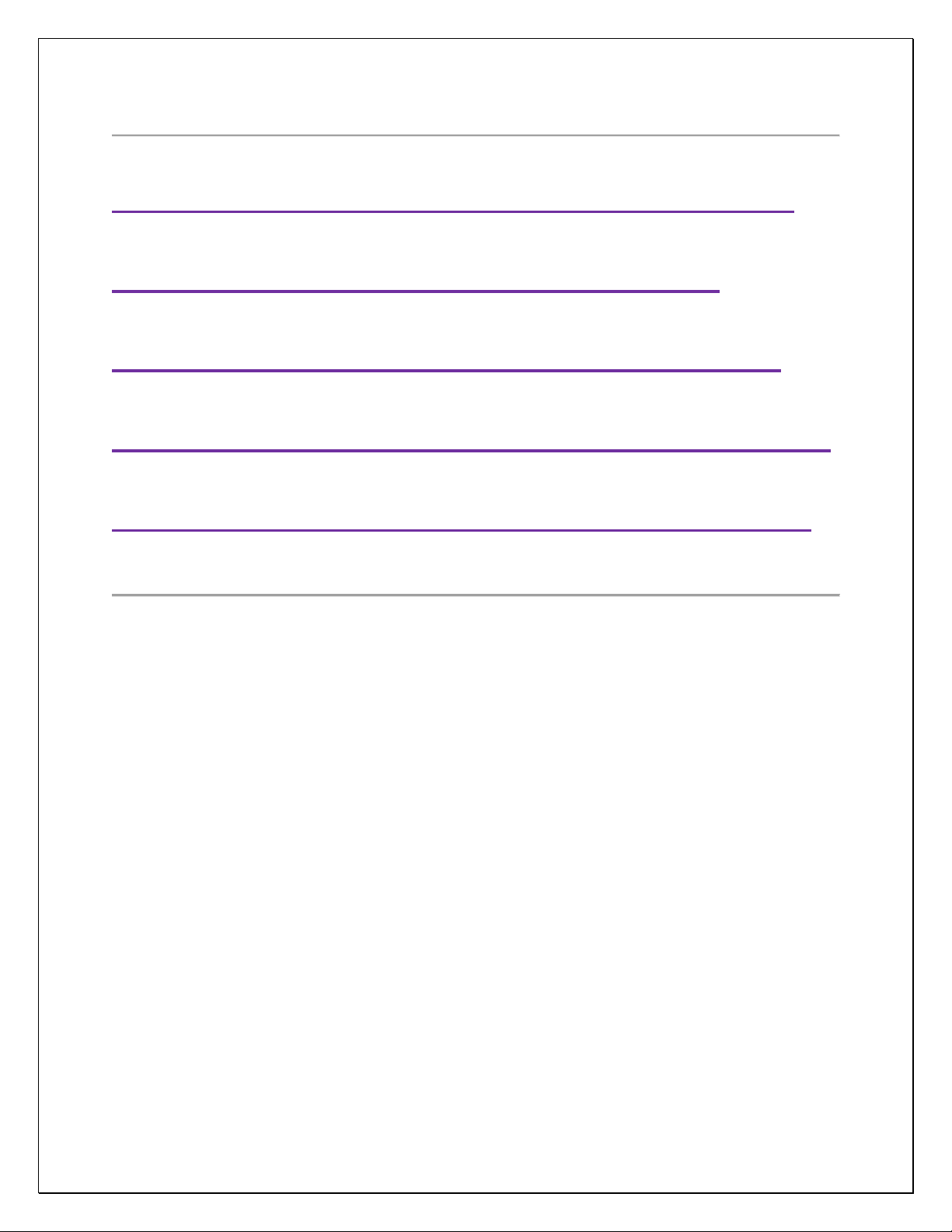
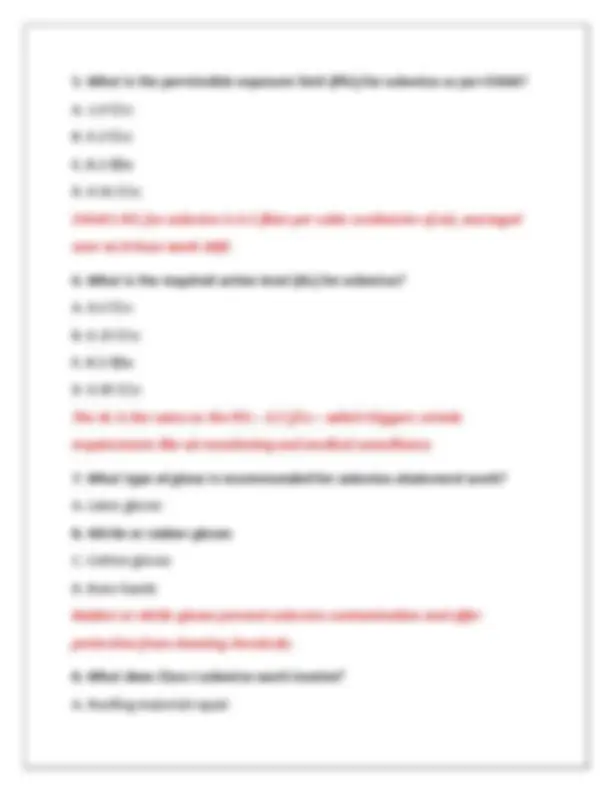
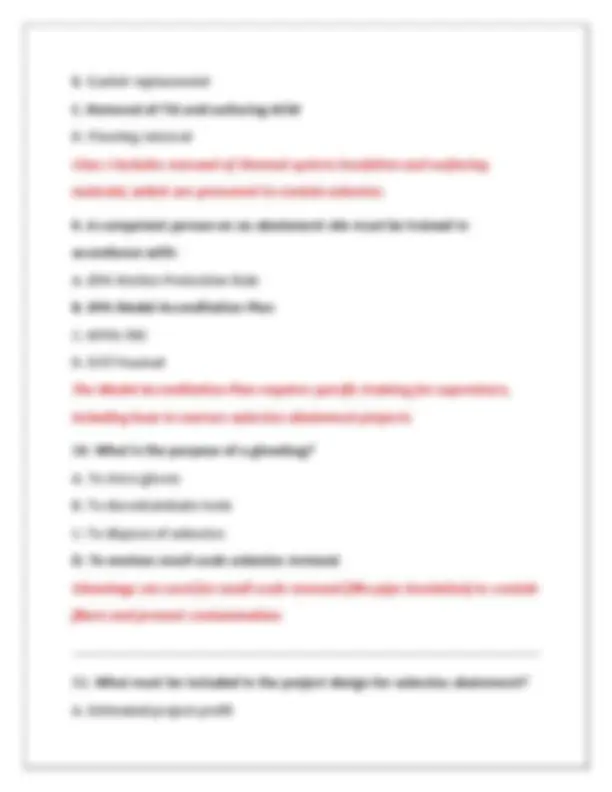
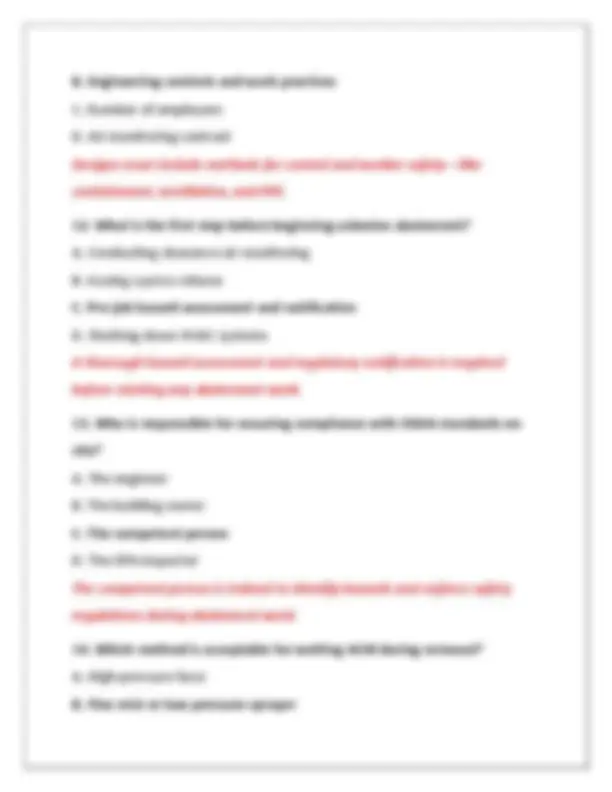
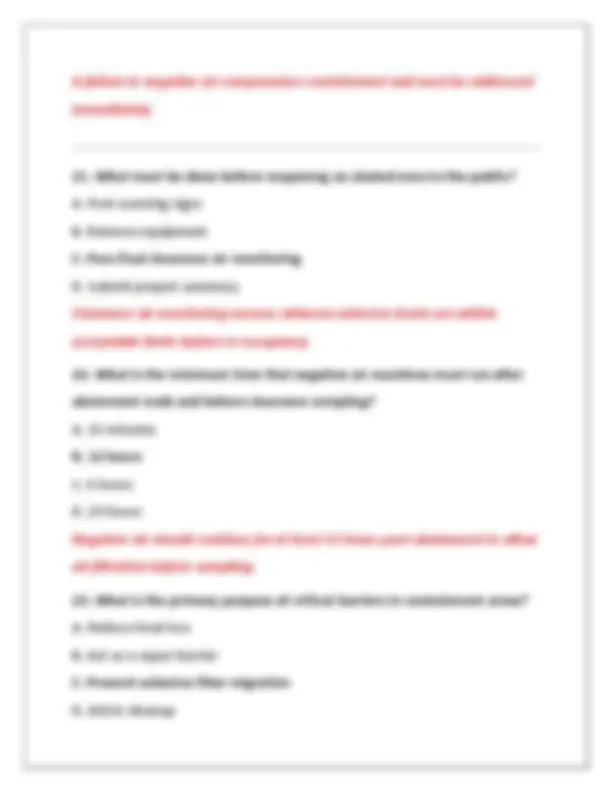
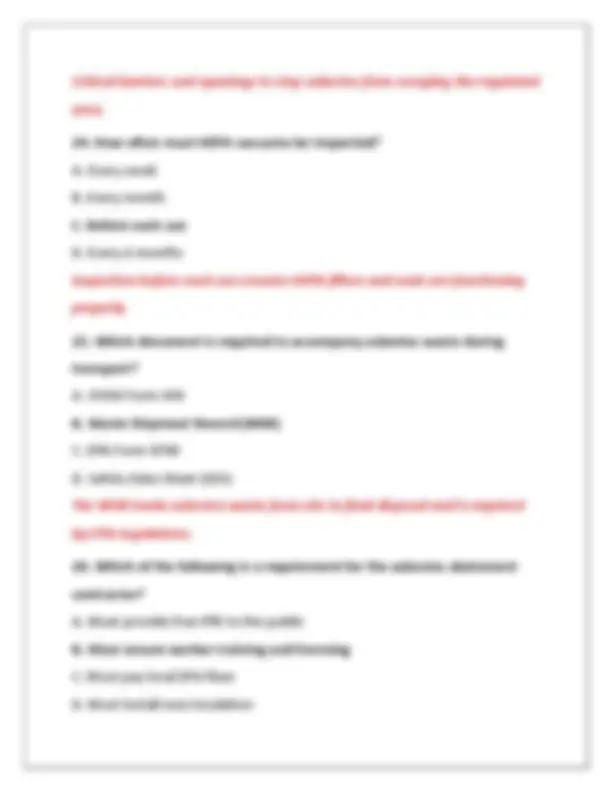
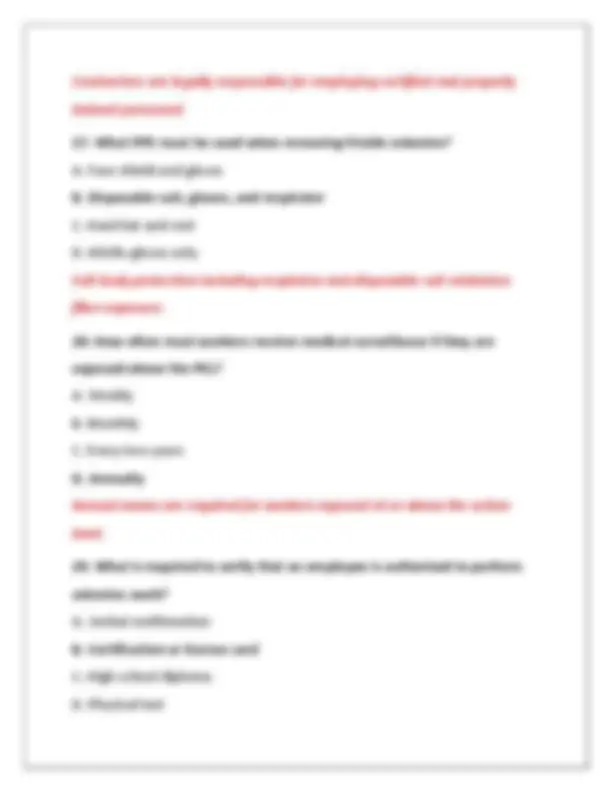
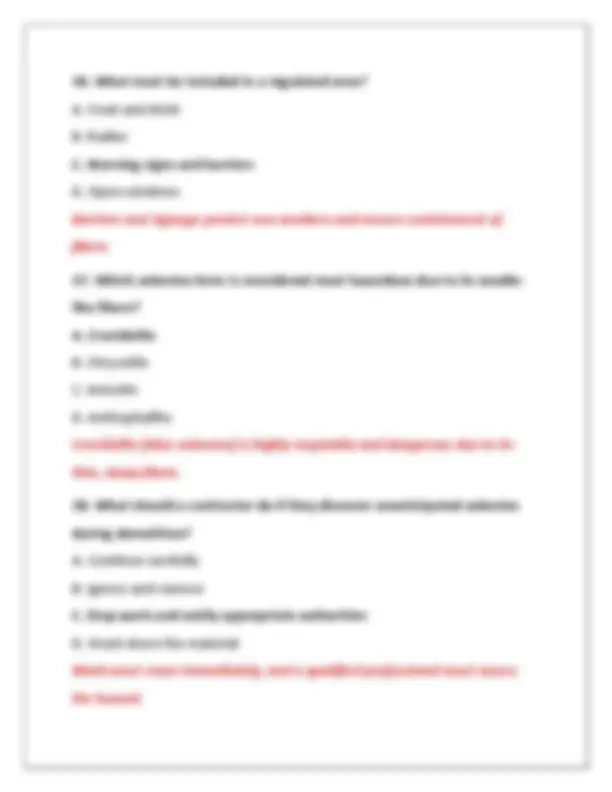
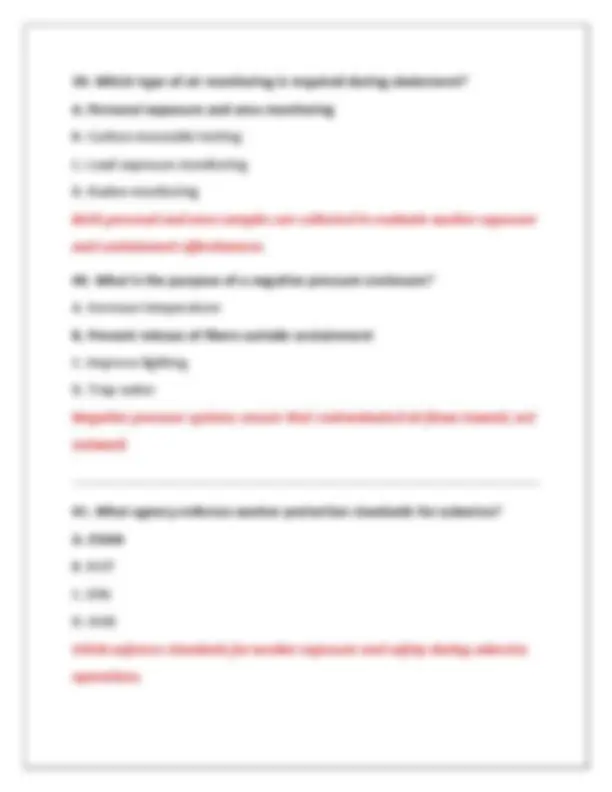
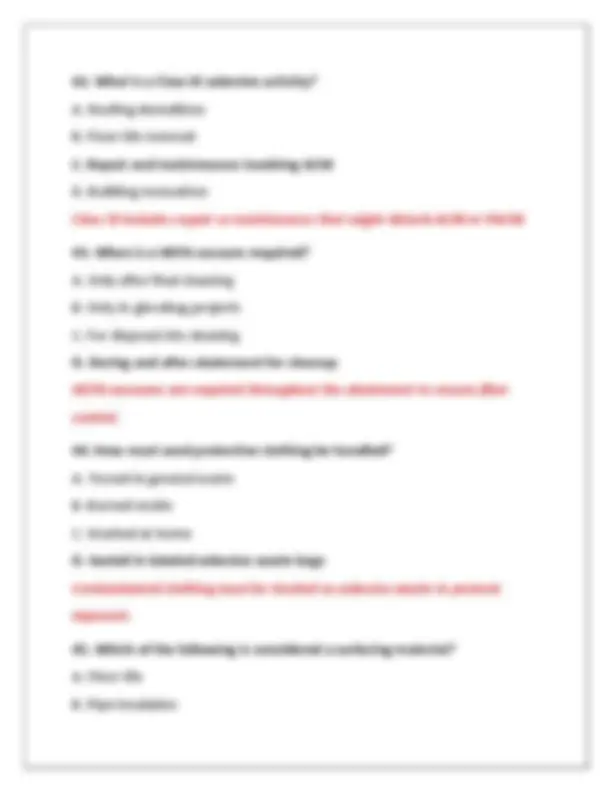
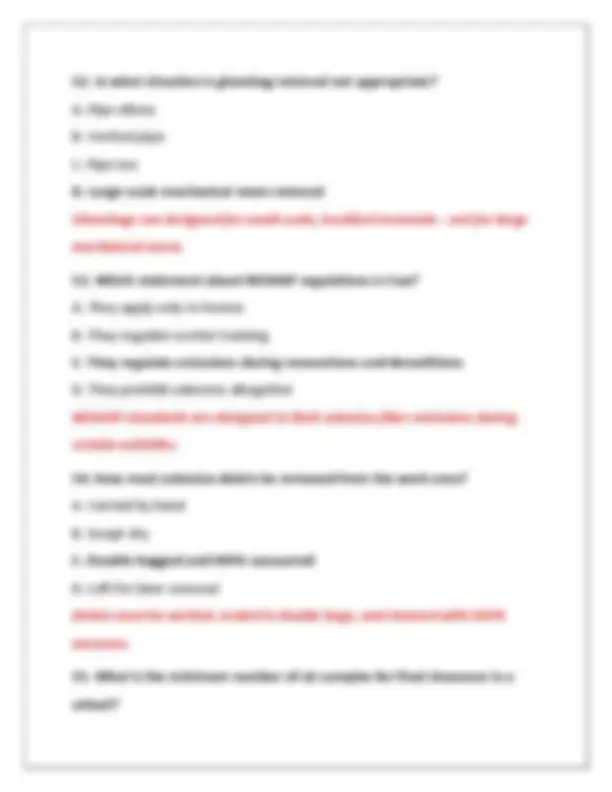
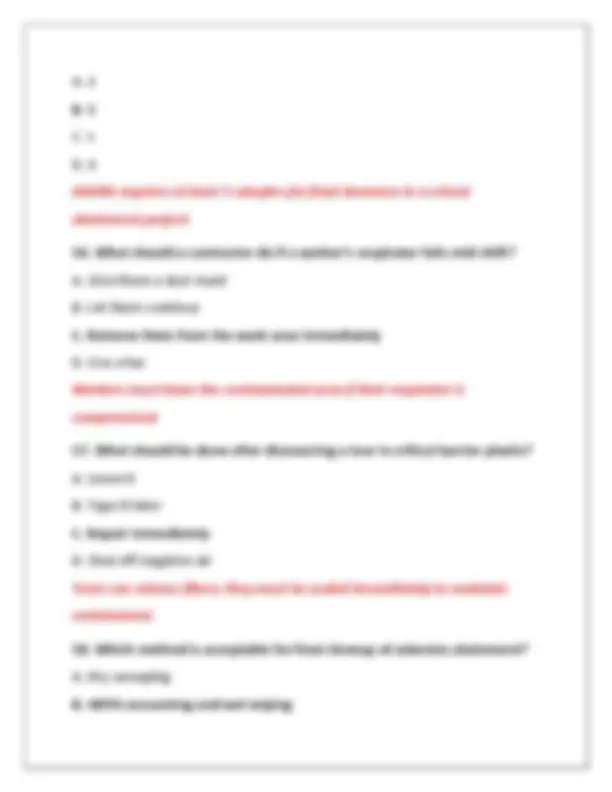
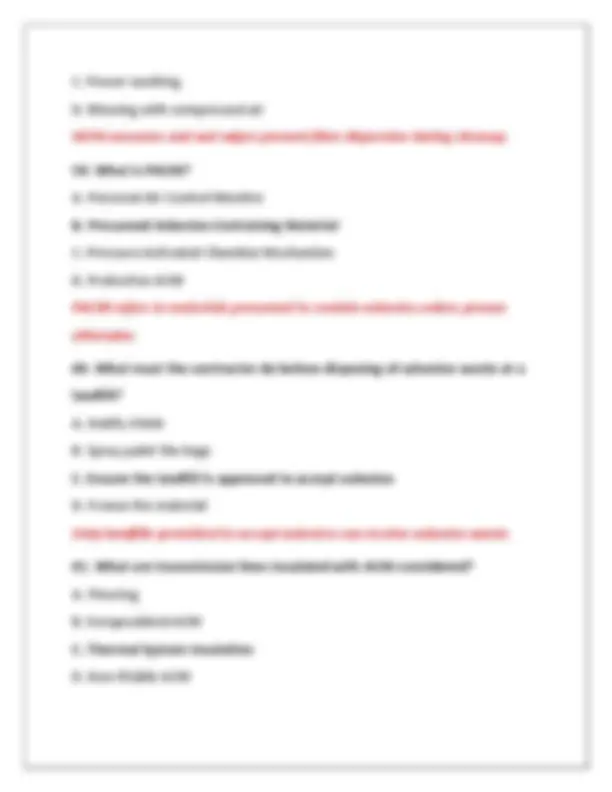
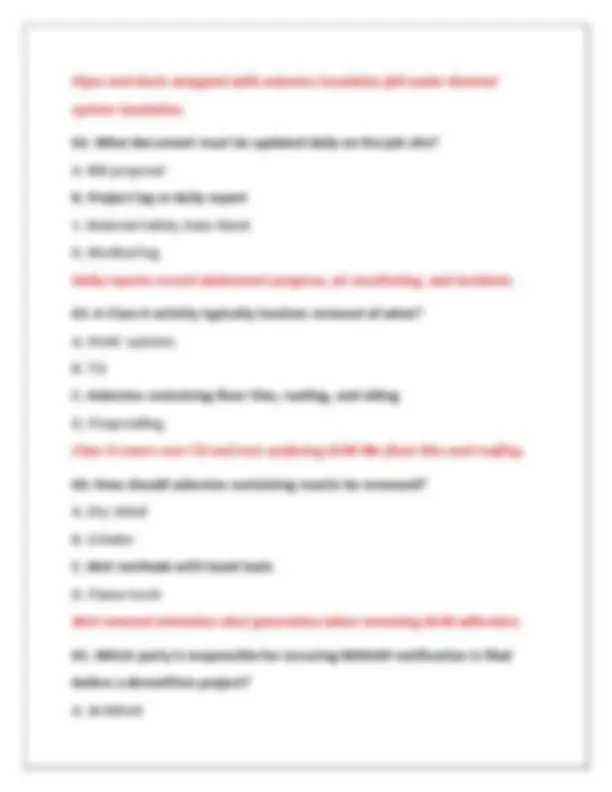
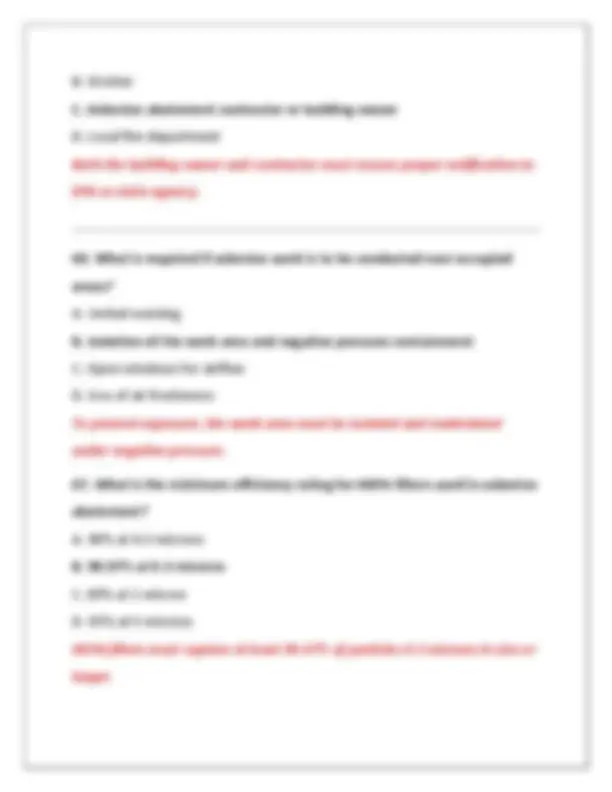
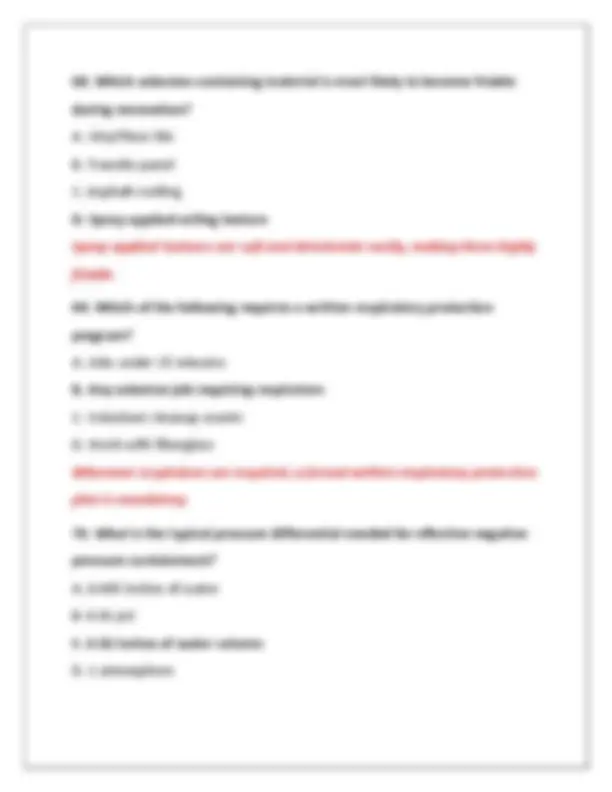
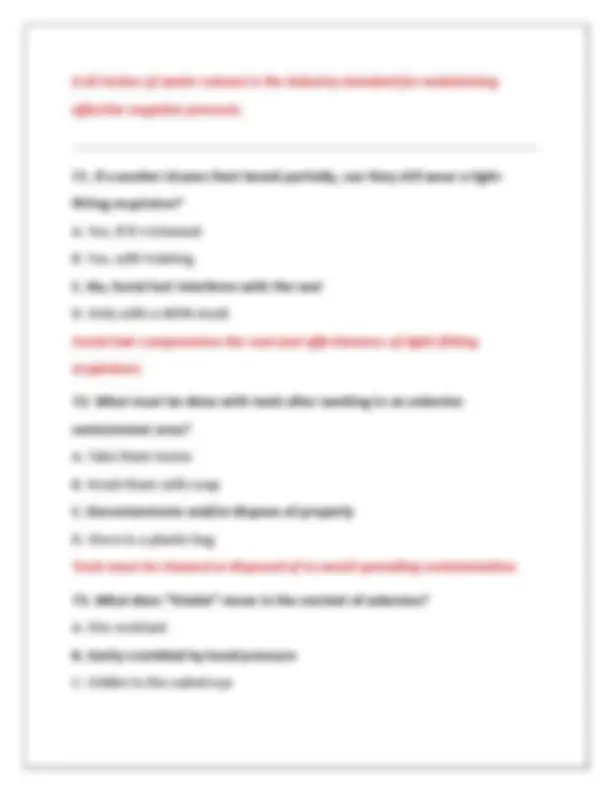
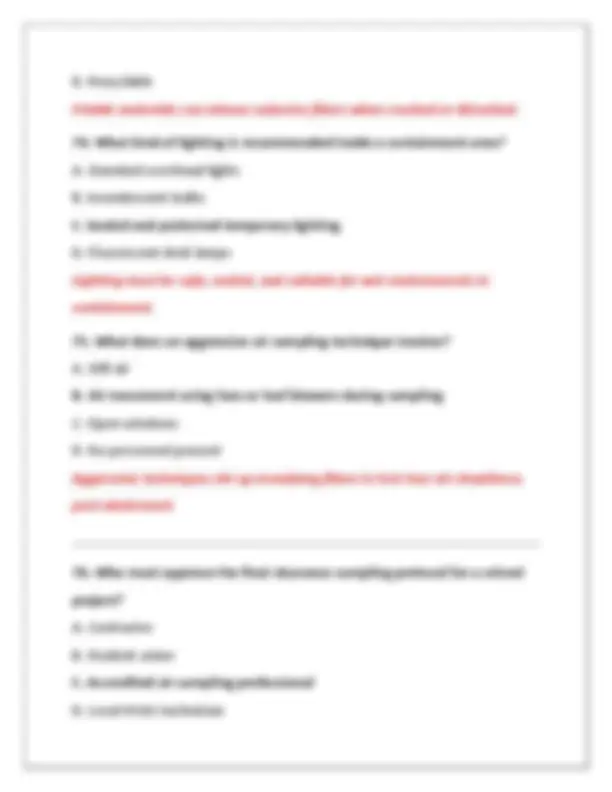
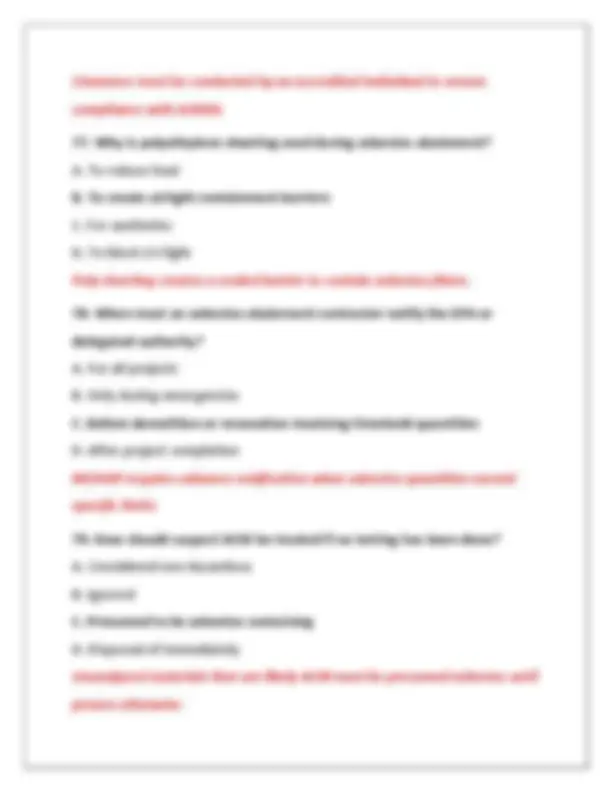
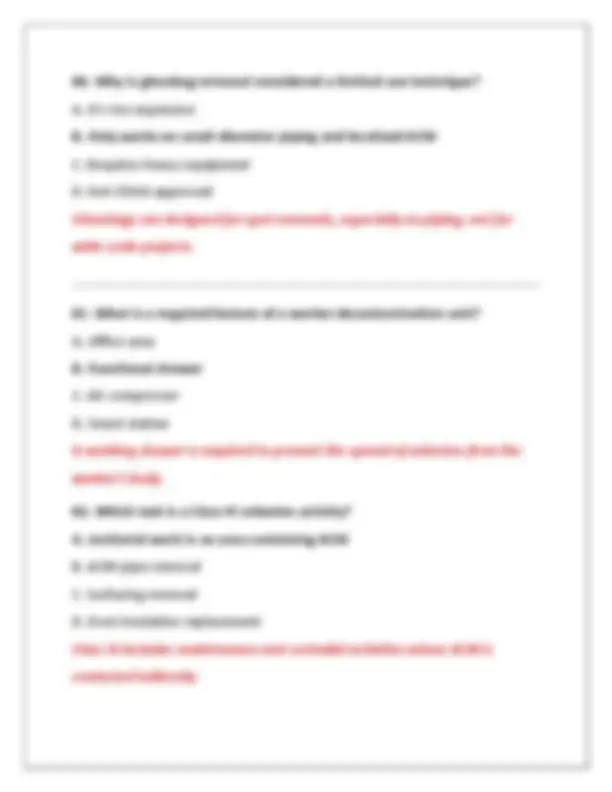
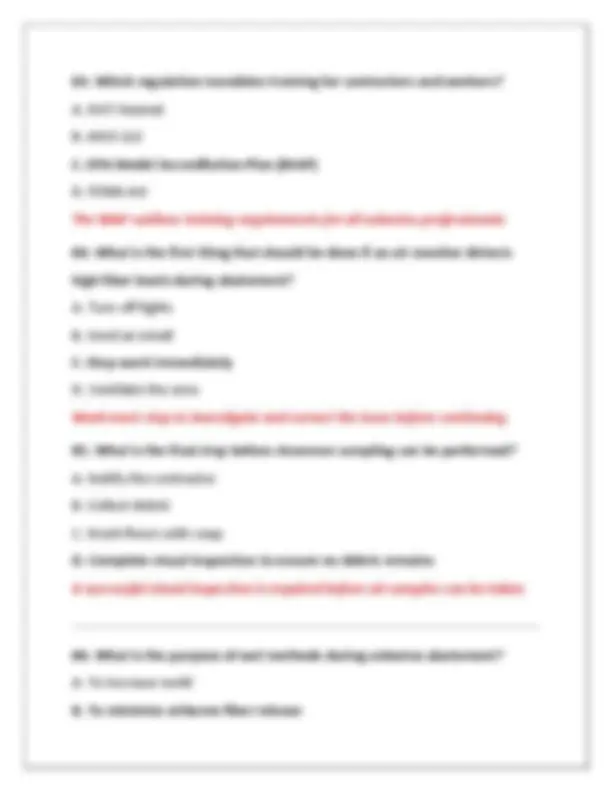
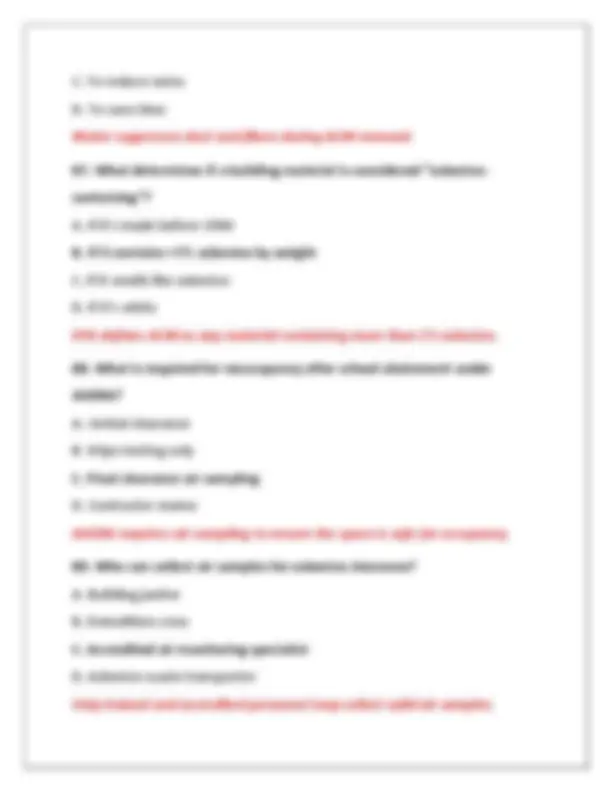
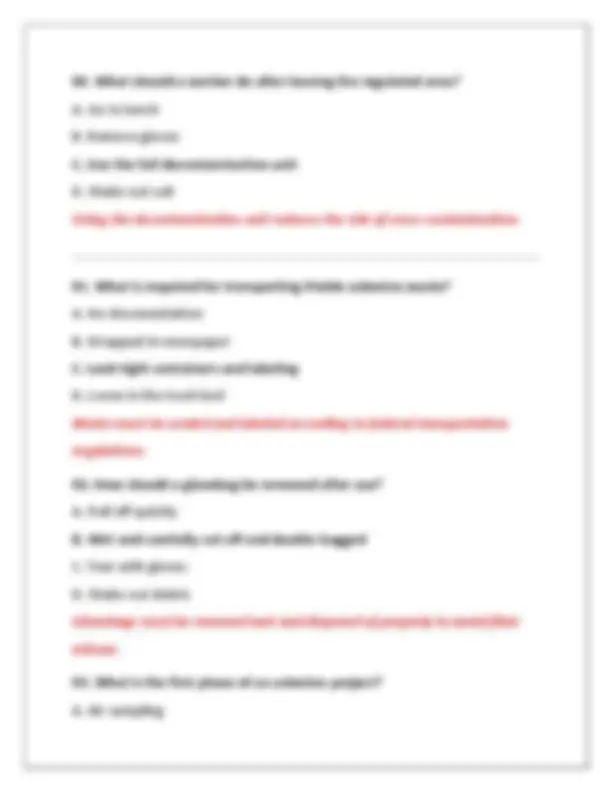
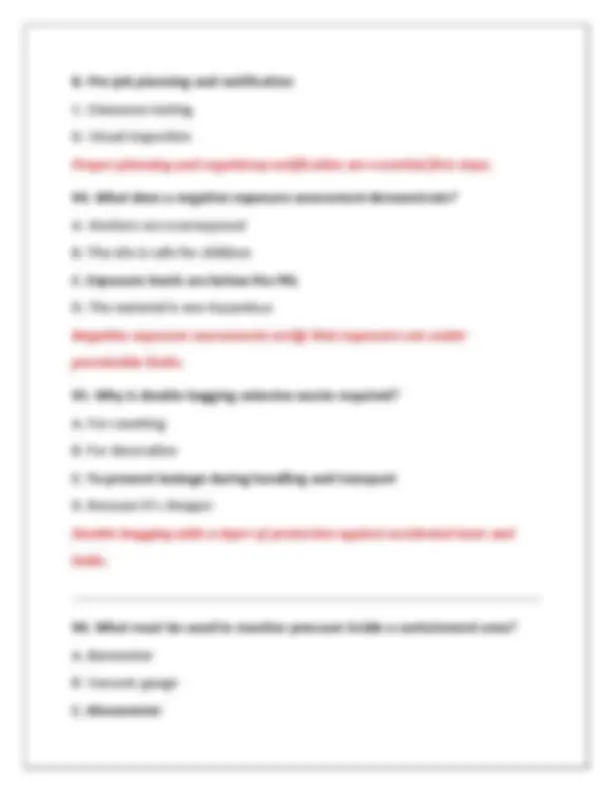
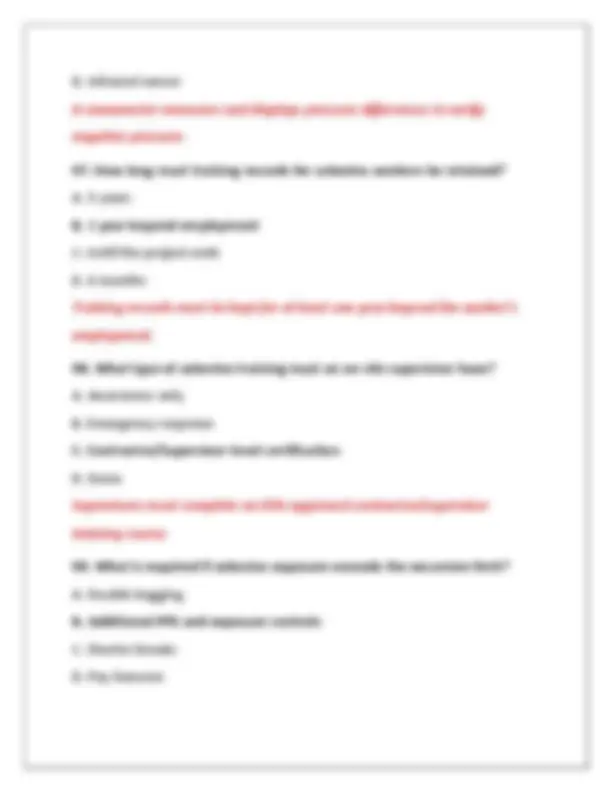
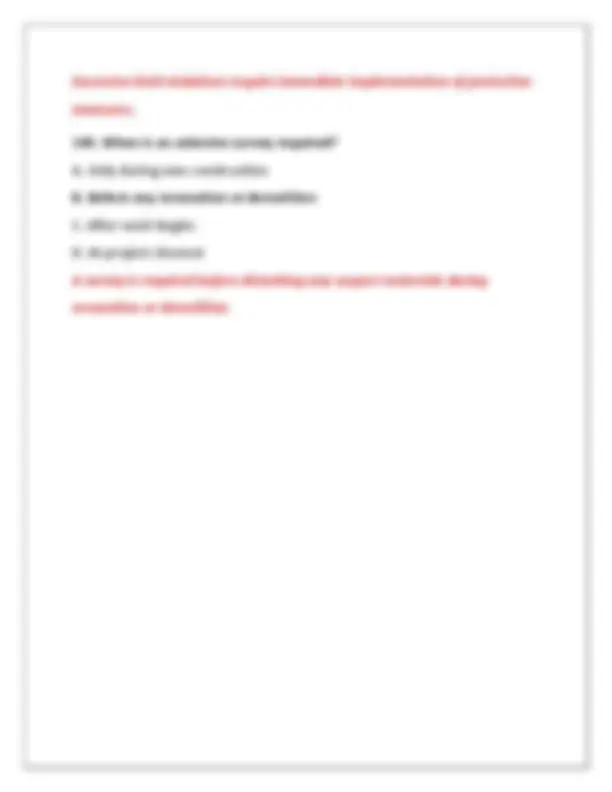


Study with the several resources on Docsity

Earn points by helping other students or get them with a premium plan


Prepare for your exams
Study with the several resources on Docsity

Earn points to download
Earn points by helping other students or get them with a premium plan
Community
Ask the community for help and clear up your study doubts
Discover the best universities in your country according to Docsity users
Free resources
Download our free guides on studying techniques, anxiety management strategies, and thesis advice from Docsity tutors
ASBESTOS ABATEMENT CONTRACTOR CERTIFICATION PRACTICE EXAM 1 QUESTIONS AND CORRECT ANSWERS (VERIFIED ANSWERS) PLUS RATIONALES 2025 Q&A | INSTANT DOWNLOAD PDF
Typology: Exams
1 / 33

This page cannot be seen from the preview
Don't miss anything!


























1. What is the primary federal regulation governing asbestos abatement activities? A. OSHA 1910. B. EPA 40 CFR Part 61, Subpart M C. DOT 49 CFR Part 172 D. ANSI Z9. This regulation, known as the NESHAP standard, governs emission standards for asbestos, including work practices during renovation and demolition.
2. What type of asbestos is most commonly found in buildings? A. Crocidolite B. Chrysotile C. Amosite D. Tremolite Chrysotile (white asbestos) accounts for about 90–95% of asbestos used in buildings due to its flexibility and heat resistance. 3. Which type of respirator is typically required for workers in Class I asbestos work? A. Dust mask B. Half-face air-purifying respirator C. Powered air-purifying respirator (PAPR) D. Full-face negative pressure respirator A full-face respirator provides eye and respiratory protection from asbestos fibers and is a minimum requirement for Class I work. 4. How often must negative exposure assessments be conducted if exposures remain consistent? A. Initially and every 6 months B. Once per year C. Every time a job starts D. Only if requested by OSHA If the exposure conditions remain constant and below the PEL, assessments should be conducted initially and then biannually.
B. Gasket replacement C. Removal of TSI and surfacing ACM D. Flooring removal Class I includes removal of thermal system insulation and surfacing material, which are presumed to contain asbestos.
9. A competent person on an abatement site must be trained in accordance with: A. EPA Worker Protection Rule B. EPA Model Accreditation Plan C. NFPA 70E D. DOT Hazmat The Model Accreditation Plan requires specific training for supervisors, including how to oversee asbestos abatement projects. 10. What is the purpose of a glovebag? A. To store gloves B. To decontaminate tools C. To dispose of asbestos D. To enclose small-scale asbestos removal Glovebags are used for small-scale removal (like pipe insulation) to contain fibers and prevent contamination. 11. What must be included in the project design for asbestos abatement? A. Estimated project profit
B. Engineering controls and work practices C. Number of employees D. Air monitoring contract Designs must include methods for control and worker safety—like containment, ventilation, and PPE.
12. What is the first step before beginning asbestos abatement? A. Conducting clearance air monitoring B. Issuing a press release C. Pre-job hazard assessment and notification D. Shutting down HVAC systems A thorough hazard assessment and regulatory notification is required before starting any abatement work. 13. Who is responsible for ensuring compliance with OSHA standards on site? A. The engineer B. The building owner C. The competent person D. The EPA inspector The competent person is trained to identify hazards and enforce safety regulations during abatement work. 14. Which method is acceptable for wetting ACM during removal? A. High-pressure hose B. Fine mist or low-pressure sprayer
Decon units must have at least three chambers: a clean room, shower, and equipment room.
18. Clearance air sampling is required after abatement in which type of facility? A. Residential homes B. Warehouses C. Commercial offices D. Schools AHERA mandates clearance testing after abatement in schools to ensure fiber levels are safe. 19. What type of filter must HEPA vacuums have? A. ULPA B. 99.97% efficiency at 0.3 microns C. 85% bag filter D. Ionization filter HEPA filters must capture at least 99.97% of airborne particles at 0. microns. 20. What should be done if a negative air machine fails during abatement? A. Keep working B. Stop work immediately and fix the issue C. Increase water spraying D. Close containment
A failure in negative air compromises containment and must be addressed immediately.
21. What must be done before reopening an abated area to the public? A. Post-warning signs B. Remove equipment C. Pass final clearance air monitoring D. Submit project summary Clearance air monitoring ensures airborne asbestos levels are within acceptable limits before re-occupancy. 22. What is the minimum time that negative air machines must run after abatement ends and before clearance sampling? A. 15 minutes B. 12 hours C. 6 hours D. 24 hours Negative air should continue for at least 12 hours post-abatement to allow air filtration before sampling. 23. What is the primary purpose of critical barriers in containment areas? A. Reduce heat loss B. Act as a vapor barrier C. Prevent asbestos fiber migration D. Aid in cleanup
Contractors are legally responsible for employing certified and properly trained personnel.
27. What PPE must be used when removing friable asbestos? A. Face shield and gloves B. Disposable suit, gloves, and respirator C. Hard hat and vest D. Nitrile gloves only Full-body protection including respirator and disposable suit minimizes fiber exposure. 28. How often must workers receive medical surveillance if they are exposed above the PEL? A. Weekly B. Monthly C. Every two years D. Annually Annual exams are required for workers exposed at or above the action level. 29. What is required to verify that an employee is authorized to perform asbestos work? A. Verbal confirmation B. Certification or license card C. High school diploma D. Physical test
Workers must possess a valid certification or license to legally perform asbestos abatement.
30. What is the purpose of airlocks in containment systems? A. Heat control B. Equipment movement C. Control airflow and maintain pressure D. Prevent visual access Airlocks allow safe entry/exit while maintaining negative pressure inside containment. 31. Which agency regulates asbestos disposal? A. OSHA B. FEMA C. EPA D. DOT The Environmental Protection Agency (EPA) regulates disposal under the NESHAP standards. 32. How must asbestos waste containers be labeled? A. "Danger – Toxic" B. "Hazardous Material" C. “DANGER: Contains Asbestos Fibers” with required warnings D. “For Construction Use Only”
36. What must be included in a regulated area? A. Food and drink B. Radios C. Warning signs and barriers D. Open windows Barriers and signage protect non-workers and ensure containment of fibers. 37. Which asbestos form is considered most hazardous due to its needle- like fibers? A. Crocidolite B. Chrysotile C. Amosite D. Anthophyllite Crocidolite (blue asbestos) is highly respirable and dangerous due to its thin, sharp fibers. 38. What should a contractor do if they discover unanticipated asbestos during demolition? A. Continue carefully B. Ignore and remove C. Stop work and notify appropriate authorities D. Wash down the material Work must cease immediately, and a qualified professional must assess the hazard.
39. Which type of air monitoring is required during abatement? A. Personal exposure and area monitoring B. Carbon monoxide testing C. Lead exposure monitoring D. Radon monitoring Both personal and area samples are collected to evaluate worker exposure and containment effectiveness. 40. What is the purpose of a negative pressure enclosure? A. Increase temperature B. Prevent release of fibers outside containment C. Improve lighting D. Trap water Negative pressure systems ensure that contaminated air flows inward, not outward. 41. What agency enforces worker protection standards for asbestos? A. OSHA B. DOT C. EPA D. HUD OSHA enforces standards for worker exposure and safety during asbestos operations.
C. Spray-applied fireproofing D. Gaskets Surfacing materials include textured or sprayed applications like fireproofing or soundproofing.
46. How long must waste shipment records be retained? A. 3 years B. 10 years C. 1 year D. 2 years EPA requires asbestos waste shipment records to be kept for at least 2 years. 47. Who can conduct final clearance air sampling? A. Abatement contractor B. Laborer C. Independent third-party air monitor D. Any certified worker Clearance sampling must be done by a third-party to ensure unbiased results. 48. What should be done to encapsulated asbestos materials? A. Remove immediately B. Cover in plastic C. Inspect regularly for damage D. Paint with latex
Encapsulated ACM must be periodically inspected to ensure the coating remains intact.
49. What triggers the need for regulated area signage? A. Any demolition B. Visible dust C. Wind speed D. Disturbance of ACM above PEL or AL Once levels are expected to or do exceed the AL or PEL, a regulated area must be clearly marked. 50. Which control method is most effective in minimizing fiber release? A. Spraying with water only B. Using respirators C. Wet methods combined with containment and HEPA filtration D. Opening windows for ventilation Wet removal combined with containment and HEPA air filtration is the most effective approach. 51. How often should fit testing for respirators be conducted? A. Every 3 years B. Annually C. Every 5 years D. Once during hire Annual fit testing ensures continued effectiveness and safety for workers using respirators.
AHERA requires at least 5 samples for final clearance in a school abatement project.
56. What should a contractor do if a worker’s respirator fails mid-shift? A. Give them a dust mask B. Let them continue C. Remove them from the work area immediately D. Use a fan Workers must leave the contaminated area if their respirator is compromised. 57. What should be done after discovering a tear in critical barrier plastic? A. Leave it B. Tape it later C. Repair immediately D. Shut off negative air Tears can release fibers; they must be sealed immediately to maintain containment. 58. Which method is acceptable for final cleanup of asbestos abatement? A. Dry sweeping B. HEPA vacuuming and wet wiping
C. Power washing D. Blowing with compressed air HEPA vacuums and wet wipes prevent fiber dispersion during cleanup.
59. What is PACM? A. Personal Air Control Monitor B. Presumed Asbestos-Containing Material C. Pressure Activated Chamber Mechanism D. Protective ACM PACM refers to materials presumed to contain asbestos unless proven otherwise. 60. What must the contractor do before disposing of asbestos waste at a landfill? A. Notify OSHA B. Spray paint the bags C. Ensure the landfill is approved to accept asbestos D. Freeze the material Only landfills permitted to accept asbestos can receive asbestos waste. 61. What are transmission lines insulated with ACM considered? A. Flooring B. Encapsulated ACM C. Thermal System Insulation D. Non-friable ACM